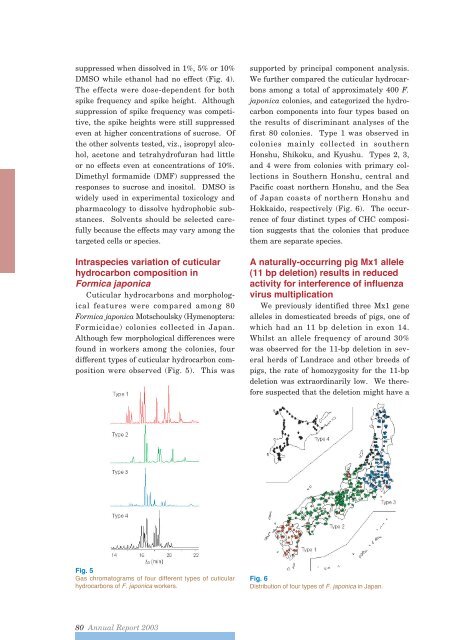Create successful ePaper yourself
Turn your PDF publications into a flip-book with our unique Google optimized e-Paper software.
suppressed when dissolved in 1%, 5% or 10%DMSO while ethanol had no effect (Fig. 4).The effects were dose-dependent for bothspike frequency and spike height. Althoughsuppression of spike frequency was competitive,the spike heights were still suppressedeven at higher concentrations of sucrose. Ofthe other solvents tested, viz., isopropyl alcohol,acetone and tetrahydrofuran had littleor no effects even at concentrations of 10%.Dimethyl formamide (DMF) suppressed theresponses to sucrose and inositol. DMSO iswidely used in experimental toxicology andpharmacology to dissolve hydrophobic substances.Solvents should be selected carefullybecause the effects may vary among thetargeted cells or species.Intraspecies variation of cuticularhydrocarbon composition inFormica japonicaCuticular hydrocarbons and morphologicalfeatures were compared among 80Formica japonica Motschoulsky (Hymenoptera:Formicidae) colonies collected in Japan.Although few morphological differences werefound in workers among the colonies, fourdifferent types of cuticular hydrocarbon compositionwere observed (Fig. 5). This wassupported by principal component analysis.We further compared the cuticular hydrocarbonsamong a total of approximately 400 F.japonica colonies, and categorized the hydrocarboncomponents into four types based onthe results of discriminant analyses of thefirst 80 colonies. Type 1 was observed incolonies mainly collected in southernHonshu, Shikoku, and Kyushu. Types 2, 3,and 4 were from colonies with primary collectionsin Southern Honshu, central andPacific coast northern Honshu, and the Seaof Japan coasts of northern Honshu andHokkaido, respectively (Fig. 6). The occurrenceof four distinct types of CHC compositionsuggests that the colonies that producethem are separate species.A naturally-occurring pig Mx1 allele(11 bp deletion) results in reducedactivity for interference of influenzavirus multiplicationWe previously identified three Mx1 genealleles in domesticated breeds of pigs, one ofwhich had an 11 bp deletion in exon 14.Whilst an allele frequency of around 30%was observed for the 11-bp deletion in severalherds of Landrace and other breeds ofpigs, the rate of homozygosity for the 11-bpdeletion was extraordinarily low. We thereforesuspected that the deletion might have aFig. 5Gas chromatograms of four different types of cuticularhydrocarbons of F. japonica workers.Fig. 6Distribution of four types of F. japonica in Japan.80 <strong>Annual</strong> <strong>Report</strong> <strong>2003</strong>













